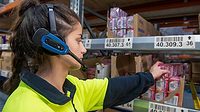Picking technology flexes to accommodate worker needs
Short timeframe needed to train workers on voice-picking, pick-to-light, pick-and-scan systems




Seventy percent of beverage warehousing distribution operations that have at least six people filling orders in each shift use voice picking, according to Dematic Corp.’s Sean O’Farrell. (Image courtesy of Dematic Corp.)




One of the most pressing problems affecting supply chains is an ongoing talent shortage, according to MHI, the Charlotte, N.C.-based material handling, logistics and supply chain association. In its 2014 annual report, “Innovations that drive supply chains,” MHI notes that the industry is having a difficult time replenishing its workforce as baby boomers retire and the number of younger workers able to replace them is scarce. With the supply-chain field expected to add 1.4 million new jobs by 2018, the issue likely will only increase in intensity, it adds.
For entry-level jobs in warehouses, employees tend not to be highly experienced, and turnover rates tend to be high, points out John Barry, vice president of sales and marketing at ITW Warehouse Automation, Arden, N.C. To combat these situations, companies have turned to automation to maintain productivity and help employees skillfully perform their duties, he says.
Picking technology solutions, like voice picking, pick-to-light and pick-and-scan, offer an opportunity to tailor picking jobs to both new and experienced workers, including foreign-language-speaking employees and manual laborers interested in working with technology. They also can help companies fulfill their workforce needs, experts suggest.
For example, when employing picking technology, new workers do not need much experience to step into these types of order-fulfillment roles; they just need to be able to follow directions, points out Lance Reese, director of technical solutions and order fulfillment for Mason, Ohio-based Intelligrated. “Voice systems provide additional benefits with step-by-step verbal instructions for performing tasks, making training and user adoption quick and easy,” he says.
Larry Edelson, marketing director for Vermont Information Processing (VIP), Colchester, Vt., says the company’s customers have told him that, prior to upgrading to voice-picking technology, it would take them a month to train a new employee. However, with voice-picking technology, new workers can be picking on their own by day three or four, he recounts.
“One of the great advantages of voice [picking] is that the picker doesn’t need to know where everything is in the warehouse,” Edelson explains. “The system gives them a location to go to and pick from; they don’t have to know what product or SKU to look for.”
Similarly, a pick-to-light system can visually guide workers around a warehouse and give instructions about how many items need to be picked, according to Kevin Sosnowski’s article “3 Reasons To Invest in a Pick-To-Light Strategy” on Manufacturing Business Technology’s website.
To meet this need, Intelligrated’s new RTS cL pick-to-light solution features bright flashing lights and easy-to-read LED displays to provide clear direction to pick locations and quantities for virtually error-free picking in a variety of fulfillment methods, including cluster and batch picking, the company says. The system’s devices also are multicolored, which enables concurrent picking activity in shared zones, it says. It also is designed to be easy to implement and introduce to employees, it adds.
The speed at which users become adapted to these systems can be a strong asset to companies during seasonal surges, according to the case study “Wyoming Liquor Division: Voice-directed fulfillment enables world-class beverage variety for the ‘Cowboy State’” by Knighted, an Elmsford, N.Y.-based software subsidiary of Intelligrated. In this way, companies can quickly integrate seasonal labor into picking operations during peak seasons, it states.
Say what?
Once users become familiar with the system and the picking process, they can change the language and playback options on voice-picking solutions to accommodate their more advanced skills. “With voice technology, less is more,” Intelligrated’s Reese explains. “Most order fillers are familiar with the process and anticipate the next command or direction. Providing the basic information without proper language and grammar results in high productivity, [as] the user is not delayed by lengthy commands.
“As for playback speed, users are again familiar with the process and train themselves to understand voice commands at speeds not recognizable to managers and non-technology users,” he continues. “Flexibility in user settings allows new order fillers to receive full instructions, while experienced users can use faster prompts with quick instruction sets to speed fulfillment.”
For example, with Honeywell Scanning and Mobility’s latest Vocollect release, the company increased the speed in which Vocollect voices can speak by 150 percent and added seven additional speed levels that workers can choose from to facilitate faster operations, says Leslie McKay, product line manager for Honeywell-Vocollect voice solutions, Pittsburgh.
Language settings for some voice-picking solutions also can be set to give commands and understand responses in languages other than English. This enables workers for whom English is a second language to receive commands in their native language and, therefore, better understand and respond to the prompts. “With immigration increasing to North America, a person with limited English skills can find a job in fulfillment operations using voice-picking in their native language,” explains Sean O’Farrell, market development director for Dematic Corp., Grand Rapids, Mich.
Knighted offers its Datria Voice picking solution, which is programmed to speak to workers in 46 different languages and dialects in 85 different voices and understand worker responses in 68 different languages and dialects, Intelligrated’s Reese says.
In addition to language options, Vocollect voice solutions allow users to select from male or female voices, and companies can even add personalized voices to the system’s 200 voice options to allow operators to listen to their preferred type of voice, Honeywell-Vocollect’s McKay says.
The efficient pick
In addition to helping employees become comfortable with their work, picking technology also helps boost efficiency, experts note.
With old paper-based picking systems, order fillers typically picked fewer than 100 lines an hour with an accuracy level of less than 98 percent, Intelligrated’s Reese says. With picking automation, workers can keep their eyes continuously on the task at hand, instead of having to constantly look at an order sheet. They also can use both of their hands to carry out a range of tasks instead of carrying a piece of paper or scanner in one hand, he explains. As a result, productivity can be boosted to as high as 250 lines an hour, he says.
Jay Blinderman, director of product marketing for Honeywell-Vocollect, also notes that the company’s beverage customers have reported safety improvements after using voice-pick technology. “Accidents and injuries have decreased, likely because workers are more focused and more aware of what’s going on around them,” he says.
Pick-and-scan technologies, like ProCat Distribution Technologies’ PickRight hands-free picking technology, can boost efficiency by helping workers plan ahead for their next pick, explains Glenn Gargone, marketing director for the West Berlin, N.J.-based company. The solution includes a wrist-worn touchscreen PC that provides at-a-glance picking information and even shows the next items that will need to be picked, he says. “This is a huge benefit to pickers attempting to build stable pallets,” he explains. In addition, PickRight can display items in different colors, such as showing less than full cases in a specific color, to help operators optimize their picking order, he says.
Right on target
Furthermore, picking technology can help boost accuracy to more than 99 percent, Intelligrated’s Reese says. “Voice directs the order filler to the location [and] then requires a location or SKU confirmation, ensuring correct pick location and resulting in higher accuracy,” he explains.
Another way to ensure order accuracy is by using the scanning part of pick-and-scan solutions. For example, with ProCat’s PickRight system, operators use a hands-free ring scanner to scan the product after they pick it to immediately verify whether or not the pick is correct. A chime will sound if the pick is correct, and a buzzer sound will alert the operator if the pick is incorrect. This provides virtually 100 percent order accuracy, ProCat’s Gargone says.
These higher accuracy rates, in turn, reduce the amount of mispicks, and the financial and reputation costs associated with them, and minimize the need for double- and triple-checking orders, which helps move the orders to the trucks and deliver them faster, Gargone adds.
Software connected to these picking technology systems also allows managers to monitor the efficiency and accuracy of these picking operations in real time. “As pickers execute orders on the floor, a dashboard provides supervisors with real-time visibility into order processes, individual picker efficiency, time remaining to complete scheduled orders, and many other valuable tools,” Knighted said in its case study. In addition, supervisors can use the system to text messages to headsets, call specific workers, or provide extra assistance to active transactions as needed, it says.
These efficiency and accuracy boosts also shorten the return-on-investment timeframe, VIP’s Edelson notes. Picking technology can pay for itself in less than 12 months, he says.
Picking, in general, is the most labor-intensive operation within the warehouse, and therefore it is the most popular supply-chain process to improve with technology, Intelligrated’s Reese points out. The benefits of this technology transcend operational benefits to facilitate a more clear-cut work environment for employees.
Choosing the right technology
With multiple options available for picking technology, production managers should carefully evaluate their choices to ensure that they select the solution that is best for their warehouses.
Lance Reese, director of technical solutions and order fulfillment for Mason, Ohio-based Intelligrated, suggests that production managers ask the following questions about the picking software they are considering purchasing:
1. Can this software keep the correct SKUs in the correct locations to maintain productivity?
2. Can this software optimize the pick-face slotting by reducing wasted space between flow lanes or slots and increase the hits per foot of order-filler travel?
3. Does this software take into account SKU velocity, family grouping, and store-aisle and value-add requirements?
4. If our system moves SKUs regularly, is this software’s process automated to ensure accurate slotting?
Beyond these software points, picking technology buyers also should evaluate their options to determine whether they deliver reliable user-system interactions and facilitate easy and quick training as well as system comfort, he says.
Looking for a reprint of this article?
From high-res PDFs to custom plaques, order your copy today!












